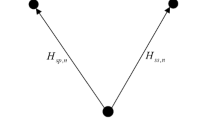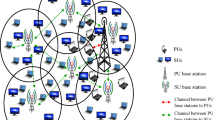Abstract
Dynamic spectrum allocation is a main challenge in the design of cognitive radio networks, which enables wireless devices to opportunistically access portions of the spectrum as they become available. Considering this challenge, this paper proposes a nonconvex power and rate management algorithm in cognitive radio networks. We apply an improved particle swarm optimization (PSO) method to deal with this nonconvexity issue directly without any assumption, which is different from prior works. Since PSO sometimes converges around the local optimum solution in the early stage of the searching process, mutation is employed to PSO which can speed up convergence and escape local optimum. We also give the numerical results, which show that the proposed algorithm can achieve higher quality solutions than other population-based optimization techniques.





Similar content being viewed by others
References
Facilitating opportunities for flexible, efficient, and reliable spectrum use employing cognitive radio technologies (ET docket no. 03-108). Technical report, Federal Communications Commission, Washington, DC, December 2003. http://hraunfoss.fcc.gov/edocspublic/attachmatch/FCC-03-322A1
Huang, J., Berry, R., & Honig, M. L. (2006). Auction-based spectrum sharing. ACM Mobile Networks and Applications, 11(3), 405–418.
Xing, Y., Mathur, C. N., Haleem, M. A., Chandramouli, R., & Subbalakshmi, K. P. (2007). Dynamic spectrum access with QoS and interference temperature constraints. IEEE Transactions on Mobile Computing, 6(4), 423–433.
Wang, W., Peng, T., & Wang, W. (2007). Optimal power control underinterference temperature constraints in cognitive radio network. In Proceedings of IEEE wireless communication network, 2007, pp. 116–120.
Yu, H., Gao, L., Li, Z., Wang, X., & Hossain, E. (2010). Pricing for uplink power control in cognitive radio networks. IEEE Transcations on Vehicular Technology, 59(4), 1769–1778.
Pao, W. C., & Chen, Y. F. (2014). Adaptive gradient-based methods for adaptive power allocation in OFDM-based cognitive radio networks. IEEE Transcations on Vehicular Technology, 63(2), 836–848.
Mokari, N., Parsaeefard, S., Saeedi, H., & Azmi, P. (2014). Cooperative secure resource allocation in cognitive radio networks with guaranteed secrecy rate for primary users. IEEE Transcations on Wireless Communications, 13(2), 1058–1073.
Islam, M. H., Liang, Y. C., & Hoang, A. T. (2007). Distributed powerand admission control for cognitive radio networks using antennaarrays. In Proceedings of IEEE symposium on new frontiers dynamic spectrum access network, Dublin, Ireland, 2007, pp. 250–253.
Zhang, L., Liang, Y. C., & Xin, Y. (2008). Joint beamforming and power allocation for multiple access channels in cognitive radio networks. IEEE Journal on Selected Areas in Communications, 26(1), 38–51.
Kim, D. I., Le, L., & Hossain, E. (2008). Joint rate and power allocation for cognitive radios in dynamic spectrum access environment. IEEE Transactions on Wireless Communications, 7(12), 5517–5527.
Cheng, P., Zhang, Z., Chen, H. H., & Qiu, P. (2008). Optimal distributed joint frequency, rate and power allocation in cognitive OFDMA systems. IET Communications, 2(6), 815–826.
Le, L. B., & Hossain, E. (2008). Resource allocation for spectrum underlay in cognitive wireless networks. IEEE Transactions on Wireless Communications, 7(12), 5306–5315.
Zhou, P., Yuan, W., Liu, W., & Cheng, W. Q. (2008). Joint power andrate control in congnitive radio networks: A game-theoreticalapproach. In Proceedings of IEEE communications, 2008, pp. 3296–3301.
Wang, W., Shin, K. G., & Wang, W. B. (2011). Joint spectrum allocation and power control for multihop cognitive radio networks. IEEE Transactions on Mobile Computing, 10(7), 1042–1055.
Tadrous, J., Sultan, A., & Nafie, M. (2011). Admission and power control for spectrum sharing cognitive radio networks. IEEE Transactions on Wireless Communications, 10(6), 1945–1955.
El-Sherif, A. A., & Mohamed, A. (2014). Joint routing and resource allocation for delay minimization in cognitive radio based mesh networks. IEEE Transactions on Wireless Communications, 13(1), 186–197.
Kennedy, J., & Eberhart, R. C. (1995). Particle swarm optimization. In Proceedings of IEEE ICNN, Perth, Australia, 1995, pp. 1942–1948.
Xu, X. L., Zhang, L. B., & Liu, X. D. (2010). Image retrieval relevance feedback algorithm based on particle swarm optimization. Acta Electronica Sinica, 38(8), 1935–1940.
Kit, Y. C., Dillon, T. S., & Kwong, C. K. (2011). Modeling of a liquid epoxy molding process using a particle swarm optimization-based fuzzy regression approach. IEEE Transactions on Industrial Informatics, 7(1), 148–158.
Gong, Y., Shen, M., Zhang, J., Kaynak, O., Chen, W., & Zhan, Z. (2012). Optimizing RFID network planning by using a particle swarm optimization algorithm with redundant reader elimination. IEEE Transactions on Industrial Informatics, 8(2), 1–13.
Shirvany, Y., Mahmood, Q., Edelvik, F., Jakobsson, S., Hedstrom, A., & Persson, M. (2014). Particle swarm optimization applied to EEG source localization of somatosensory evoked potentials. IEEE Transcations on Neural Systems and Rehabilitation Engineering, 22(1), 11–20.
Sun, J., Palade, V., Wu, X. J., Fang, W., & Wang, Z. Y. (2014). Solving the power economic dispatch problem with generator constraints by random drift particle swarm optimization. IEEE Transcations on Industrial Informatics, 10(1), 222–232.
Tang, M. Q., Long, C. N., Guan, X. P., & Wei, X. J. (2012). Nonconvex dynamic spectrum allocation for cognitive radio networks via particle swarm optimization and simulated annealing. Computer Networks, 56(11), 2690–699.
Chiang, M., Zhang, S., & Hande, P. (2005). Distributed rateallocation for inelastic flows: Optimization frameworks, optimalityconditions, and optimal algorithms. In Proceedings of IEEE INFOCOM, 2005, pp. 2679–2690.
Shi, Y., & Eberhart, R. C. (1999). Empirical study of particle swarm optimization. In Proceedings of IEEEE Evolutionary Computation, 1999, Washington, DC, pp. 1945–1950.
Liu, B., Wang, L., Jin, Y., Tang, F., & Huang, D. (2005). Improved particle swarm optimization combined with chaos. Chaos, Solitons and Fractals, 25, 1261–1271.
Higashi, N., & Iba, H. (2003). Particle swarm optimization with Gaussian mutation. In Proceedings of IEEE swarm intelligence symposium (SIS’03), Apr. 2003, pp. 72–79.
Wang, Y. X., Xiang, Q. L., & Zhao, Z. D. (2010). Particle swarm optimizer with adaptive tabu and mutation: a unified framework for efficient mutation operators. ACM Transactions on Autonomous and Adaptive Systems, 5(1), 1–27.
Acknowledgments
This work is supported by National Science Foundation of China Grants 61174097, 61172064, 61374108, Science Foundation of Shandong 2015ZRB01121.
Author information
Authors and Affiliations
Corresponding author
Rights and permissions
About this article
Cite this article
Tang, M., Xin, Y., Long, C. et al. Optimizing Power and Rate in Cognitive Radio Networks using Improved Particle Swarm Optimization with Mutation Strategy. Wireless Pers Commun 89, 1027–1043 (2016). https://doi.org/10.1007/s11277-016-3303-z
Published:
Issue Date:
DOI: https://doi.org/10.1007/s11277-016-3303-z




